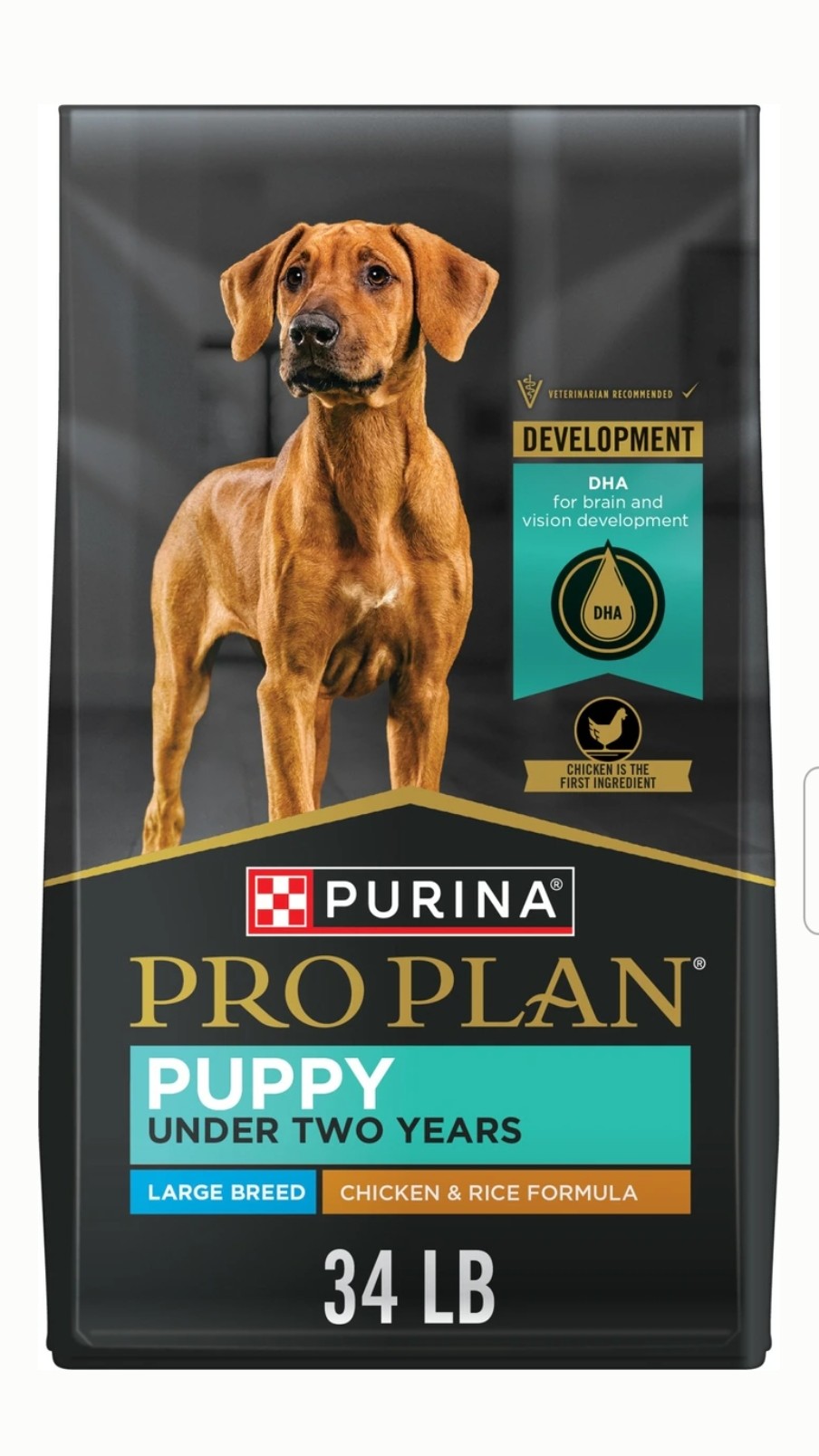 Eating & Drinking
Eating & Drinking Care instructions for bringing home your new puppy. Please read, I promise it will be helpful !
Get some whole milk plain yogurt at home for your puppy. It will help your puppy eat well and settle their nervous belly on their first day. There is more information about the benefits of yogurt below. Please read the information I provided below. Everything I have written is important and helpful.
~ Your puppy will be clean, but might be damp. Bring a blanket! They can shiver because of nerves and a chill. Pups do get motion sickness, keep taking them for rides they will grow out of it quickly. If you see them drooling a lot they are probably going to get car sick, so bring some paper towels in case you need to clean up. Let me know if you need food, I am happy to provide some to get you by for a few days. It is very important to keep them on the same food for now.
 Eating & Drinking
Eating & Drinking
For the first day you should have some plain whole milk yogurt on hand, just add a couple spoonfuls on top of their kibble. DO NOT LIMIT THEIR FOOD, KEEP A FULL BOWL OF FOOD OUT FOR THE FIRST FEW MONTHS OR MORE!
They are new born babies they must gain weight each day. Let them eat! Add a couple spoonfuls of yogurt right on top of that kibble, no need to mix. It will settle their stomach if they are nervous and do not feel like eating the first day. Your pup is use to having a full bowl of food at all times, they are not going to go to their dish and finish a helping, they will graze and come back for more later. You do not need to teach your puppy when to eat, nature will take care of that. Let your puppy eat when they are hungry, their body's should dictate their amount of food and when they need to eat. Puppies DO NOT over eat.
Fresh full bowl of water at all times, but you can limit it an hour before bed.
Most Labradoodle's do not over eat until much later in life. You can just keep an open bowl policy for a couple years, pups do not over eat and become obese..
More about Food- Real whole foods are not "people food"! Chicken, beef, fish, eggs, pork and so on are protein and real whole foods. This is much cheaper, and better for your puppy! Kibble is important and a good staple for you dog, However it is heavily processed!!!! YUCK!!! You should supplement your dogs food at an early age, with real whole food. Do not feed from the pan, or your plate, or feed while you are cooking. Instead when adding real food to you pups diet put it in their dish on their kibble. I believe introducing foods at a young age help dogs later in life tolerate more food, instead of spending a fortune on limited ingredient kibble that is not nearly as healthy for your dog as real whole food. You do not want your dog to have a sensitive stomach. My pups get whole milk yogurt every day. My adults get it a few times per week. The reason I like yogurt added to their diet is because of the pro-biotics. It absolutely helps with digestive health! If they get something they shouldn't, too many treats, or have a belly ache for any reason, yogurt will settle their stomach, stiffen soft stool, and keep their digestive tract healthy. If your dog is not feeling well, not eating or drinking, the vet will tell you to give them a couple spoonfuls of yogurt, it will help. My pups and dogs alike will have chicken, apples, peanut butter, oatmeal, salmon, beef, rice, pumpkin, sweet potatoes, eggs, carrots, and lots of other real whole foods. Of course some food that humans eat can be toxic for dogs, so know your foods. NO grapes, raisins, chocolate, onions, or garlic, and no added sugar foods. I also do not think corn and wheat are good grains for anyone!
Potty training - Put the hard work in the first few days! 1st day take them out every hour, 2nd day you might be able to go a bit longer. But if you can avoid an accident in the house, or at least limit accidents, they won't associate your house with going potty, and Potty training will be easy and quick. If you don't put the hard work in the first couple days, you will drag in out for weeks, it will be harder, you will clean up more. You can't discipline a pup for accidents at this age, but if you catch them in the act, gasp say no, and rush them out, then praise. With any training encouraging good behavior is just as important as discouraging bad behavior. At night, the first couple days you will probably need to take your pup outside for potty. Let the pup wake you up, do not set your alarm. They just need time to get used to holding it in over night.
Do not let you pup jump on you, or climb up your leg. If they want attention they will typically put their front paws on your legs trying to climb up because they want your attention or to be held. Our natural instinct is to reach down and pet them, if you do, you have just encouraged your pup to jump on people. Not acceptable! Make them sit and be calm, then pour on the love, and encouragement when they are sitting, tell them how good they are, lots of petting and then you can hold them. Treats are also a good way to encourage. My daughter demonstrates making a pup sit in this video, do it often this will help behavior training with your puppy.
Training is very important, you have to be a strong pack leader or the Labradoodle will feel the need to take over. They are smart, teaching them tricks will help your pup know who his/her leader is. Children should be teaching their pups tricks, it will show your puppy the kids are their leader too!
Puppies will bite! Biggest problem families have is the biting. The pups miss their litter mates, and the playtime, rough housing they used to be able to do with the other pups. They might try to treat you or the smallest member in the family , like a litter mate. play ball, play chase, burn off that energy! Take walks, 1 a day is not enough!!! Having said this, newborn puppies can not take long walks at first. They can damage their growing joints if they are over exercised. Your walks for the first few weeks will be acclimating your puppy to a leash and leading them. Doing a little more each week. Perhaps you walk around your block the first week, you will carry your pup most of the way. When they want, let them down and try to teach them to walk with the family. But it is a process and takes time.
The discipline I use for biting is holding their mouth shut, a little squeeze and say NO in a loud deep voice! You might have to do it 5 - 10 times, but you should have a no tolerance policy with using any human parts as a chew toy. After the correction redirect with a toy, and play with them. They need you to play with them, and teach them how to play without biting you.
Crate - Keep the crate positive. Use it for a toy box, hide treats in it, and keep the door open for your pup to use as a bed. Pups do like a fluffy bed, and putting a stuffed animal in at night to cuddle with might help.
Put the crate in your room at night for the first few nights, or sleep next to it. If your puppy wakes up in the middle of the night and doesn't smell anyone, sense anyone, has not litter mates, doesn't know where they are, they are going to get upset. If their first night in their crate is upsetting and scary you are making your pups impressions on their crate being locked up alone, and certainly not positive.
Your puppy will probably have to go out at least 1 x during the first few nights, maybe only 1 night. Another reason you want to be close to the crate at night, is because you want to hear your pup wake you when they have to go out and go potty. Do not set your alarm and start bad habits of getting up at night, remember you are trying to get them to sleep through the night within a week of being home. Let them wake you to go out. Also pups are used to eating any time they want when they are here. You shouldn't put food and water in their crate, but doesn't hurt to throw a handful of kibble loosely in the crate for the first few nights, it will tie over their hunger till morning, and looking around for the kibble gives them something to do before they fall asleep. They will likely be very whinny the first night in a crate.
If your puppy is locked in a crate more than they are out of the crate, that is a big problem, and you shouldn't have a Labradoodle. A crate is an excellent tool to use for house training, you want to keep them and your home safe and sound when you are sleeping or away. But if you are still locking your pup in a crate when they are 9 -12 months old, that is too much, you really need to start the process of trusting them in their homes.
Giving a Bath - I will give your pup a bath just before you pick them up, and I won't handle them again until you arrive. I will use gloves to pick them up and bring them to you, so it will be safe to finally hug and snuggle your little angel! So your pup will not need a bath in the first couple weeks. When you do give them a bath, always just use tear free baby shampoo and you do not need a lot of soap and suds, You do need to rinse and rinse and then rinse again! ALWAYS put cotton balls in their ears before a bath even when they are old. You need to keep that moisture out! After a bath or a swim or anytime you think there is moisture in your puppy or adult dogs ears clean them out with a cotton ball and rubbing alcohol.
 The food the puppies are eating is Purina Pro Plan large breed puppy food . There are a lot of varieties of this food, be sure to get the exact kind. DO NOT change food instantly. It is very important that you continue using this food at least until they are use to their new homes. If you switch their food right away they WILL have soft stool or diarrhea, which makes it a lot harder to house break, and is terrible for their health! If you do switch the food wait at least a month. When you switch an adult or puppy's food make the transition over about two weeks or more, 75% old with 25% new, then 50/50, and the last days of the transition 25% old 75% new. I can give you a small bag of food to get you started.
The food the puppies are eating is Purina Pro Plan large breed puppy food . There are a lot of varieties of this food, be sure to get the exact kind. DO NOT change food instantly. It is very important that you continue using this food at least until they are use to their new homes. If you switch their food right away they WILL have soft stool or diarrhea, which makes it a lot harder to house break, and is terrible for their health! If you do switch the food wait at least a month. When you switch an adult or puppy's food make the transition over about two weeks or more, 75% old with 25% new, then 50/50, and the last days of the transition 25% old 75% new. I can give you a small bag of food to get you started.
Do not hesitate to contact me with any questions
They will need chew toys, and more chew toys. Rope toys are usually a favorite, and can be thrown into the washer and they love to chew on them. However just like anything else. Some dogs chew things until they are destroyed. You can not give a toy and leave your pup unattended until you know what they are capable of doing to that toy. Rope toys will unravel, if that starts happening throw it out! Raw hides are also good but do not buy the cheap ones! They must be Thick and big, they should be bigger than your puppy. Raw hides expand when wet, so if they get a big piece off that could give them an upset stomach. Raw hides that are made to look cute such as moccasins, candy canes, etc. are junk, don't buy them. Raw hides are good chew toys, key word CHEW toy, it is not meant to be eaten, you have to get a BIG THICK one
A real beef Soup bone, sold in your meat department, or at a butcher are the best bones!! They have the marrow still in them, which is a very healthy treat! This is the only food I serve raw to my dogs. Dogs can handle more bacteria than we can, but too much bacteria will give them stomach/digestive issues and will make them sick. I do not recommend any raw food besides the soup bones. I do highly recommend having pro-biotics on hand for your doggy's. I always serve the soup bones with pro-biotics. Anything from a helping of yogurt to powder or chew pro-biotics such as FortiFlora.
Labradoodle's are extremely smart, and need to learn. The learning toys they make today are great!!
Of course they will need 2 dishes, stainless steel or ceramic - non tip are best!! Plastic dishes can cause little bumps around their mouth and nose. The dishes that are raised are ok, but some dogs like to lay down and eat. It has been debunked that a dog that stands to eat is less likely to getting a stomach turn. The dish being on the ground, or raised makes no difference.
Crates are an excellent way to train and a nice safe place that your puppy will love!! I highly recommend everyone get one!! You should be sure not to go to small, they should be able to get up and move around easily, stretch out if they want. At night, or if you are away from home you can not just let your little angel wander about. There are to many unsafe things around a household , and they need to learn the house rules before they can be left out alone. A crate that is at least for 45lbs - 65 lbs a medium sized crate. I recommend the metal crates as opposed to the travel crates, they have way more ventilation. Keep your crate positive! Do not over use your crate, your dog should be aloud to roam around the house while alone before they are a year old. Dogs that are in the crate to long will get anxiety, and end up with behavioral issues.
POTTY TRAINING ~ Take your pup out often in the first few days (1Xper hour) , if you can avoid an accident from the beginning your little angel will easily associate going potty with out side. If you watch their behavior closely you will be able to tell when they have to go. They will be unsettled and looking for a spot, perhaps spinning around. Get them outside quick if you see this behavior. Always praise them like they have just saved the world when they go potty outside. After your pup has been in their new home for a few days, you've taken them out often, your off to a good start with housebreaking, now you need to help them gain some control and help them be able to hold it in for longer periods of time. For instance if you are using a crate at night and you are getting them up around 2am to go potty, start making them wait till 2:30 for a couple of nights then 3, and so on. Before long they will be able to hold it in all night and during the day you shouldn't have to take them out so often. Pups get the ability to hold it in longer at 5 - 8 weeks old.
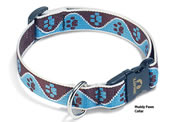 Collars that snap on and adjust are great for identification Only, These types of collars account for a lot of lost dogs when you connect a leash to it. . Dogs that are scared because of a noise or any situation, will back out of their collar. PLease DO NOT use these collars for walks, only for ID. An adjustable collar between 10-16 inches is good, because they grow so fast. Walking leads or choke chains (slip collars) with a leash are what you will need to walk your pup. If you use a snap on or regular collar they are going to learn to pull you on their walks!
Collars that snap on and adjust are great for identification Only, These types of collars account for a lot of lost dogs when you connect a leash to it. . Dogs that are scared because of a noise or any situation, will back out of their collar. PLease DO NOT use these collars for walks, only for ID. An adjustable collar between 10-16 inches is good, because they grow so fast. Walking leads or choke chains (slip collars) with a leash are what you will need to walk your pup. If you use a snap on or regular collar they are going to learn to pull you on their walks!
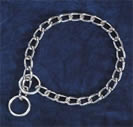 A Choke Chain DOES NOT choke your dog, unless you are letting them pull until they choke themselves.
A Choke Chain DOES NOT choke your dog, unless you are letting them pull until they choke themselves.
This type of collar or a slip lead is best for teaching a dog to walk on a leash because of the way they work. They should be placed just behind their ears and under their chin.
is best for teaching a dog to walk on a leash because of the way they work. They should be placed just behind their ears and under their chin.
A small slip lead or loop lead like this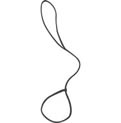 Is the best thing to use to teach and train a pup to walk on a leash. You could get a regular collar to keep on your angel all the time, then just slip on their lead for walks.
Is the best thing to use to teach and train a pup to walk on a leash. You could get a regular collar to keep on your angel all the time, then just slip on their lead for walks.
After your little angel is trained with walking on a leash then a retractable leash can be used to give them a little more space to explore.
You will need a slicker brush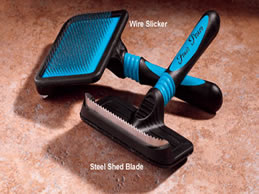 , a Comb
, a Comb , and a de-matting tool
, and a de-matting tool 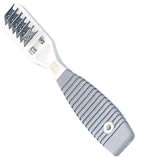 . There are many tear free puppy and dog shampoo's on the market that are good and specific for problem skin if needed. To many to list, just remember you get what you pay for. I always recommend plain old Johnson & Johnson tear free baby shampoo, to get started with, for your pup.
. There are many tear free puppy and dog shampoo's on the market that are good and specific for problem skin if needed. To many to list, just remember you get what you pay for. I always recommend plain old Johnson & Johnson tear free baby shampoo, to get started with, for your pup.
Vet Visit Your pup will leave our home dew clawed, current on vaccines and wormings, and will have had a check up by the vet. We will provide you with their medical record/statement from our vet. You will need to take that record to your pups first appointment with their new doctor. They will need a set of 3 vaccines total , every 3 - 4 weeks. My vet gives their first set and they will probably be in their new homes by the time they need the next set.
The big day - Pick up day Please contact me with the day and time you would like to pick up your angel. I will give them a bath and have them all ready to go. If you are traveling alone to pick up your pup, please bring a crate. If someone will be with you then a lap will be fine for the ride home. We will go over their medical record and answer any questions you have. Also remember I am here for you and your angel their entire life, never hesitate to contact me with any questions or concerns! If you still have a balance on the day of pick up please bring cash, or if you prefer to pay with credit or debit card, I ask that you process the transaction before you arrive to pick up, or call me with your info and I can process it from here. If you would like to pay with a check, I must receive the check 10 days before pick up. I do not accept checks on the day of pick up.
I put a great deal of time and care into my pups!! My mothers are power fed until the pups are about 4 weeks old. This provides them with added protein and calcium. Then I slowly return my mothers back to their normal diet. My mothers DO NOT go through labor and delivery alone! I am with them every step of the way, no matter what time day or night. I hand deliver each pup and cut the cord myself, hopeful helping to avoid any umbilical hernia's. After each pup is born the cord is cut and they are all cleaned up by mommy, I put the puppy on a nipple and make sure it begins eating. It is so important for the mother, that each nipple is being used equally. It is imperative that each pup eat well several times a day! This is why I spend hours and hours with puppies. This is another reason why my pups are so well socialized. This is my system for a happy healthy Beautiful puppy.
Before your puppy leaves my home they will have had a trip to their vet to have their dew-claws removed (3-5 days old), worming's (4, 5, 6 wks), they will be current with VET administered vaccines, and Vet check ups. My Vet is Nicole Wernette DVM, of Mayville Veterinary Clinic. Everyone at Mayville Vet does a great job! I highly recommend them if you live in my area. A lot of Breeders and Kennels administer vaccines themselves and they never actually take their puppies to see the Vet. All of my pups are Vet checked! All of my puppies are well socialized! I do not work outside of my home. This is my job and I take it very seriously! I spend a lot of time with all of my dogs and my puppies. I even take notes on each pups behavior and personality. This way I can help match just the right puppy with your families lifestyle. For instance A puppy who is real active and likes to play a lot would be better with an active family maybe with kids. A puppy that is a little more laid back and prefers to watch the action from afar, that puppy might be better for a quiet home.
Bringing your new baby home: - The first day home for a new puppy can be scary for them. After all they have been hearing the same voices, smelling the same scents, and they are used to being with their litter mates. We want to make the transition as easy as possible. It is a good idea if you can make visits to your little angel before the big day. Some new parents have brought toys or blankets up to leave with their puppy. I encourage that! That way the puppies will have something from their old home to take with them to their new home. It helps to give them a since of security, they feel safe with something familiar. Bring your puppy home on a quiet day. A day that you are not expecting any company and you will be able to stay home as well. Your puppy will need his or her "own room". What I mean by that is they have to have an area of their own where they know they will be safe. This is the 1st place you should show your pup when they get home. At night or when your not home your puppy should be confined to an area where it won't hurt themselves our damage your home. A lot of people use crates for this, or you can simply corner off an area of your house with a baby gate, and put in a bed, food, and chew toys. If you use a crate it must be a large enough crate for your puppy to grow, and be able to stand and move around in. Keep the area or crate open when you are home so the pup can walk in and out as it pleases. You only need to do this until your puppy is trained, and knows the rules of the house. Do not use his area/crate for punishing!!!!
Dog proof your house just like baby proofing there are some things you need to do. Keep household cleaners out of reach, or in a cupboard. watch your plants! some plants are dangerous to dogs, Poinsettias, azaleas, rhododendrons, Japanese yew, English ivy, and probably more but these are the ones I know. Keep your floor clean, they can find the smallest little things to eat off the floor. Especially when they are pups and teething. Also it is very important to cover or hide electric cords. If you have a pool or hot tub that are not fenced in you need to be careful. Dogs could walk out onto a pool cover.
Meeting the children - Kids get so excited bringing home a new puppy. Here are some rules to explain to them: NO TEASING! that can and usually does lead to bad habits like jumping up on people or even biting. Teach your children to be gentle when they play no tail pulling. Supervise your children when thy are holding puppies. My puppies are all large or medium breeds, and usually don't like to be held after they get bigger. Also NO RUNNING around the pup the first day or so, it will only scare them!
Training - When you get your puppy home before taking them inside, show them their yard and their boundaries. Praise them like they just saved the universe when they go potty outside. Treats can help with that!! You have to be consistent and simple when you train a pup. Use the same simple one syllable words over and over. Such as NO! The tone of your voice is important too. You do not have to yell at your puppy just use a stern voice and stay consistent! It is important to teach this to your children, they will be part of the learning process for your puppy. If everyone in your house is using the same simple words and staying consistent, your pup will be trained a lot faster. Most dogs just want to please their owners, when you're happy, they are happy. Frequent Bathroom breaks the 1st week or 2 is the best way to housebreak. If you can take them out every couple of hours that is for the best! Take them out as much as you can, after any activity like eating or playing, but always after waking up.
It is a very good idea to have some of the essentials bought and waiting at home for your new pup. You can always take them out to show off after they are a little more comfortable with their new family. I use Chewy.com for all of my food, beds, and treats.
I use Petedge.com for all my grooming purchases. Petedge is geared towards grooming professionals and kennels, so if you don't buy a lot, shipping is expensive. If you need a product you can't find on amazon, chewy, or most stores, contact me. I can get it on petedge with my next order and you won't have to pay shipping. :)
Food and nutrition - I use Pro Plan puppy food. My puppies start eating softened puppy food at about 4 weeks old, when their teeth come in. They will also continue to stay on mothers milk until they are 5 1/2 weeks old.
I recommend Purina Pro Plan for puppies until they are about a 8-10 months old. Then I switch my dogs to a Purina adult food. It is important that you use a quality food!!!!!!!!!! Generic pet foods may appear to be a bargain until you realize that they don't provide the needed nutrition your dog needs to stay healthy and fight sickness. Cheaper foods DO cause U.T.I.'S in a lot of pets, even if the label shows that the ingredients are the same as more expensive foods, it is the quality of the ingredients that is the difference!!!!!. I do not recommend soft foods at all. They are not good for your dogs teeth and they can make your dogs stool even more fowl smelling and loose. Maybe use canned foods as more of an occasional treat. Do not switch your dogs food, stay consistent once you choose a quality food. If you do switch foods it is important to do so gradually. On the first day you would want to have the mixture be 75% old food 25% new food, the next day 50/50, and the 3rd day 25% old food 75% new. Your dogs stool will soften when you switch. If your dogs stool does not become normal and firm again within a a week or so after the complete switch over your new food may not agree with your dog. All dogs are different just like people, some foods do not work for some dogs.
Quality dog foods: There are so many great foods on the market, they do not have to be expensive to be a quality food. Do your research and choose a food that is good for your dog, and affordable, plus easy to acquire.
Human foods- Be very careful giving your dog table scraps! Some human foods are harmful or even fatal to dogs. CHOCOLATE, RAISINS, GRAPES, ONIONS, RAW EGGS, RAW MEAT OR POULTRY, CHICKEN BONES THAT SPINTER